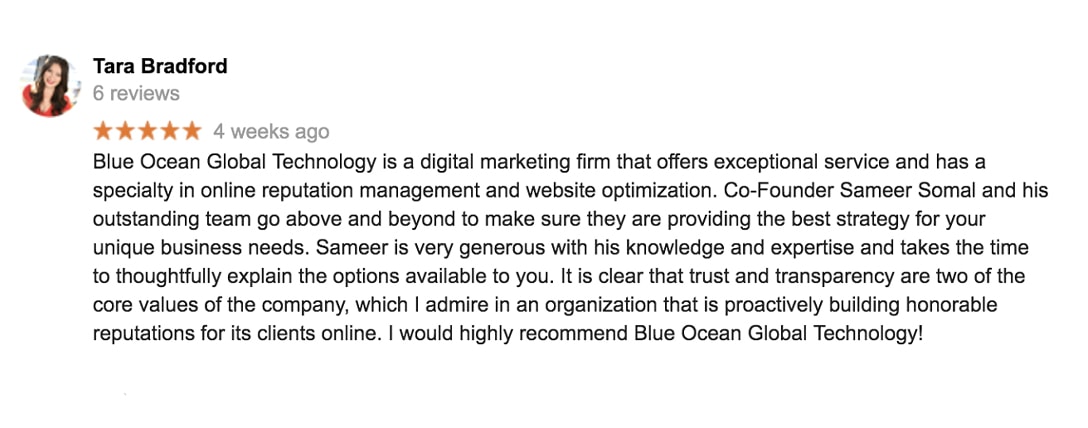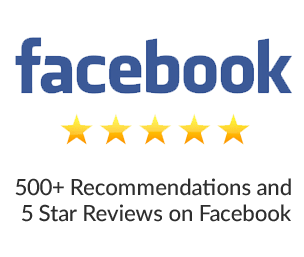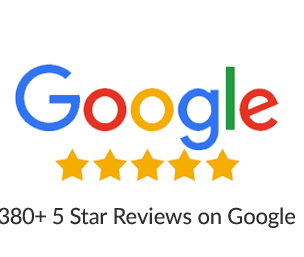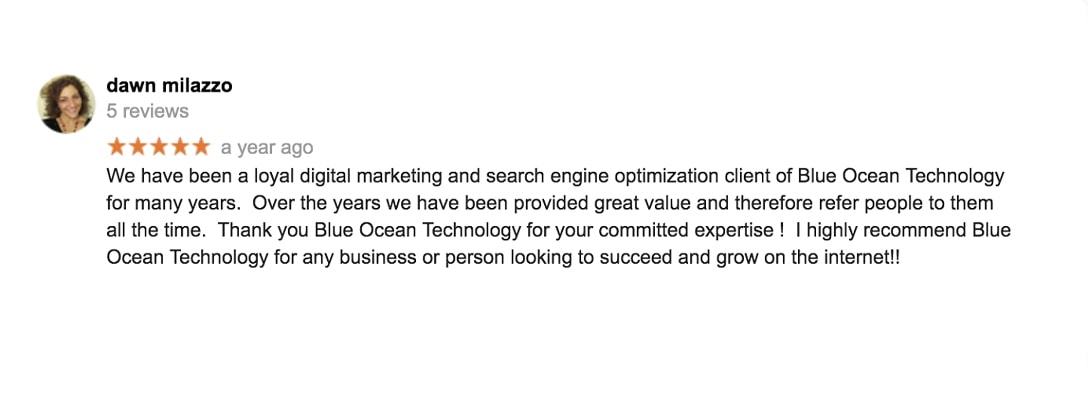A positive reputation is a valuable asset. You deserve to be in control of what the internet says about you or your brand. We specialize in building, monitoring, and protecting digital reputations. Schedule time with our team to audit your existing digital presence and find ways to elevate and enhance your online impression.

Please note: All names were changed for privacy reasons.
Blue Ocean Global Technology specializes in comprehensive online reputation management, which includes extensive reputation repair experience. We follow a structured but flexible process for rehabilitating a company or individual’s digital prestige. Solving reputation issues during crisis is one of our core competences. We are trusted by some of the most agile and reputable public relations firms. In the following case study, we highlight an example of how we repaired a company's reputation that had been damaged on the internet. Because restoring an online reputation is a new and evolving field, clients often times cause more harm than good when they attempt to rectify a situation on their own or engage professionals that employ ‘quick-fix’ solutions. We sincerely hope that this case study provides you clarity and guides how you navigate current or future online reputation management challenges.

An Affair with Consequences
Because the foundation of our company is education, we are asked to speak regularly at conferences and host open discussion forums on digital reputation. Attendees approach openly or in confidence seeking actionable advice on how to build their company’s digital presence and neutralize unfavorable content appearing prominently on search engines.
After one of the aforementioned conference speaking engagements in earlier 2017, Mr. Lee Daniels introduced himself and asked to speak in private immediately. Mr. Daniels, who now prefers we call him Lee, is the CEO & President of a diversified financial advisory firm. Founded in 1978, Fortitude Wealth Ltd. is a 400+ employee company providing a wide range wealth management services, including investment consulting, private real estate LLPs, financial planning and tax services. Fortitude Wealth Ltd. offers a compelling platform for experienced and growth financial advisors who seek succession or transition partner. He competes directly with major brokerages, including Wells Fargo, Merrill Lynch, Morgan Stanley, Raymond James and Edward Jones.
In 2016, Fortitude Wealth faced a public relations crisis when several senior employees, including one minority shareholder, were deceptive and committed fraudulent acts. Clients were recommended financial products that did not align with their risk tolerance and investment objectives. Client funds were knowingly comingled with employee personal accounts. An immediate investigation commenced. The perpetrators in question were then fired and cited for violations by the Financial Industry Regulatory Authority (FINRA) and Security Exchange Commission (SEC). The fraud and clients affected were covered quite extensively by regional and supra-regional news outlets. A widow and a retired couple, whom each lost more than half of their life savings, were featured continuously. As a result of the negative publicity, undesirable content seemed to pop up everywhere online and on social media. These articles and content began ranking with increased prominence on Google when searching Fortitude Wealth or even the name of a key employee not involved in the transgressions. The negative publicity had a disastrous impact on new business and even current clients started mentioning the news with increased frequency.
Entering a branded search term with keyword “Fortitude Wealth” was enough to find most of the defamatory content. Unfortunately, almost every single publication failed to acknowledge the fact that the fraudsters were no longer associated with the company and were terminated with cause after the Fortitude Wealth investigation. To compound the matter, several innocent Fortitude team members were arrested and charged erroneously. While they were later exonerated and found innocent of all wrongdoing, they still appeared guilty online. This small yet crucial detail was overlooked.
Digital reputation crisis issues:

It became quite difficult for Fortitude Wealth to attract both new clients and recruit experienced portfolio managers or financial advisors. Either the interested party would ask about the news after stating their discomfort or they would abruptly decline working with Fortitude Wealth without a clear explanation. Even the close ratio of referrals from existing clients declined.

Existing clients, employees and partners became worried and focused on the negative news, even after resolving all legal issues and terminating employees. Frequent questions included: "Where does all the negative PR come from?”, “Why is the company in so much trouble?” and “How can Fortitude stay out of the news?"

Fortitude Wealth ’s acquisition opportunities and pipeline dried up. One large advisory firm that had agreed in contract to be acquired backed out. The acquisition candidate didn't want to join an entity that was struggling to maintain an A+ reputation; they grew tired of trying to assure their employees and clients. The transaction was almost a major milestone for Fortitude Wealth 's shareholders. According to Lee, that lost opportunity was the tipping point for him to focus full-time on finding a permanent solution.
What did the people at Fortitude Wealth do to try to minimize the damage prior to hiring Blue Ocean Global Technology?
- Fortitude approached the publisher of each article with a request to have the negative content removed. Unfortunately, as is often the case with these kinds of websites, their requests either remain unheard, unanswered or get rejected. Because they are often times harassed and contacted with such frequency, news outlets may have an unwritten policy not to deal directly with the party mentioned in an article.
- Direct contact with Google, Yahoo and Bing search engine customer service didn’t bear any fruit.
- Fortitude Wealth’s Chief Marketing Officer hired an agency that claimed to be an “SEO expert”. With little repair experience, the agency created obscure and confusing content. Some of the news results temporarily moved to lower pages for a few months, but later returned to even higher positions. Furthermore, the new content that used the Fortitude Wealth name was confusing, off topic and not reflective of their industry leadership.
- Bottom line: All attempts to have the detrimental content removed or suppressed turned out to be a complete failure and exacerbated the problem. Digital reputation repair expertise was required immediately to address the crisis.
Talk to an Expert Today for your Digital Reputation & Repair Consultation.
Assessing the Situation
We visited Fortitude’s offices and interviewed key members of Lee’s team. Begin with the end in mind. To formulate an optimal action plan, we must become an extension of our client’s team and connect on a personal level where possible. This has been our approach for years: invest in new relationships, earn trust, and never take shortcuts. By nourishing these initial conversations into relationships, we lay the foundation from which to work upon. Our reputation grows organically and through word of mouth. Our process and how we assessed the problems up front are often cited when receiving referral introductions.
Naturally, the first step in a reputation repair situation is to thoroughly review and assess the situation. While intellectual capital and knowledge gained from past success are helpful, each online reputation management case is unique. We need to know the full scope of the problem at hand before developing a roadmap to the solution. Our recommendations outline each step necessary to repair the harm that had been done, while also providing a longer-term framework for how to build positive online visibility. This serves a dual purpose of neutralizing the negative while simultaneously highlighting the authenticity of our clients. This proactive approach helps insulate and protect a digital profile from future reputational issues.
Together we evaluated how difficult it was going to be to either remove or outrank (suppress) any of the links that we did not want to see on the front pages of search. We often use “search or search engine” and “Google” interchangeable because Google is the dominant player that accounts for the majority of web traffic. Thus, it became our main focus. The goal: Dominate the first 4 pages of the SERPs (Search Engine Results Pages) within a realistic time frame of less than 6 – 8 months. In order to achieve that goal, we had to analyze 17 unique pieces of negative content spread out over 13 different domains.

Content Removal
Attempting to remove negative content is a cornerstone ORM (Online Reputation Management) technique. If we feel there is chance to remove links right away, we make that attempt. This was definitely the case with Fortitude Wealth. Negotiating removals when approaching a publisher directly involves significant time and resources, along with tact and emotional intelligence. Each company or website has their own procedure for requesting content to be taken down. From experience, we know that the chances for success may be relatively small, but we always try to weaken the defamatory links through monthly suppression. For Fortitude, we were successful to at least some extent as you are going to find out soon. Another option to achieve removals is at search engine or hosting company level (the most desirable outcome). Lastly, removals may be assisted by the appropriate attorney in our network or via court ordered injunction. We often attempt several of these content removal options at various points during the repair process.

Content Suppression
Simply put, content suppression means outranking undesirable links with positive content with either already exists online or new content that our team curates and publishes. Google’s algorithm dictates results when a keyword is search, and this ever-evolving formula is complicated. To suppress effectively and gradually so as not to alert Google, our team deploys significant manpower and technical resources. There are many factors that affect the ranking of a web page for a particular keyword search. New high-performance articles may need to be created, published and optimized for ranking. For Fortitude Wealth, we hired a PR agency to originate high-quality articles and media placement. We also saw an opportunity in SEO-optimizing some of the already existing content that was ranking on the fourth page and beyond.

Going into Action
Rather than laying out every single step that we took to repair Fortitude Wealth ‘s damaged reputation in this case study, we will highlight a few key aspects and explain their specific context so that you can comprehend what we did and why we did it.
We will start with what we call the Content Removal Phase. Then we will give you an example for how you can create and/or optimize articles, posts and other types of content that Google will value. We also want to highlight one very specific issue: other financial service providers in the industry are named very similar to our client’s company. As a result, information for those companies was also showing up when searching for Fortitude Wealth. This was confusing and added another variable to account for.
Talk to an Expert Today for your Digital Reputation & Repair Consultation.
Content Removal Phase
The reason why we always start with content removals first is because you never know how successful (or unsuccessful) you are going to be. The more success you have, the less work needs to be done in the suppression phase. Having said that, content removals may be unsuccessful at the onset but more achievable later in the process after several attempts and continued suppression.
With respect to the different removal strategies, we reached out to all 13 news outlets and prepared ourselves for tough conversations and inevitable negotiation. We appealed to everyone’s common sense, arguing that the fraudsters responsible for the mischief were no longer with the company through presentation of required proofs. We focused on a respectful and tactful approach to explaining our client’s plight. At the same time we knew that persistence and patience are key. We didn’t receive an answer or even any sympathy from most news outlets in round 1, so we reached out a second time and eventually a third. Please note this is done through a combination of phone, email, website submission, US mail letters and social media direct messaging to decision makers. I can’t stress enough how important it is to show humility and kindness at this point.
What was the outcome? Two publishers agreed to take down their news reports right away and even replied with acknowledgement confirmations to our second written request. One of these two was actually responsible for two of the target negative articles published, which meant 3 of the 17 links were gone! After speaking with the managing editor of another publication via introduction from one of our PR partners, another website agreed to remove all firm name mentions but keep the article. This accomplished our objective in that it no longer appeared after being reindexed by Google. This left us with 13.
Unfortunately, the rest of the back and forth between us and the remaining news sites was not crowned with success – at least not until we made legal requests (more in a second). But first we tried to have some of the pages entirely de-indexed from Google so that they would only be accessible if you enter the URL directly in your browser.
For a potential deindexation, content has to violate either applicable laws – think defamation – or Google’s own Terms of Service. When a potential policy violation is identified, Google will review the content before restricting access or simply removing it from their index. After researching and making our case for an image copyright violation, another link was neutralized from the Fortitude Wealth search engine results pages (SERPs).
For the remaining 12 pages, we also tried removal at hosting company level. Even after hours of reconciling technical requirements, we could not find any qualified compliance violations that may have justified action against the publisher. The sites in question were of high quality and up to date as per agreed upon hosting guidelines.
No reason to despair. We still had an ace up our sleeve: Attorney-assisted removals. In our first expert.com case study Why Efficient Online Reputation Repair Involves More Than Content Suppression. I’ve mentioned that “Websites and hosting companies have no legal obligation to remove content unless a court determines that the content harms the interested party and is false and defamatory, as outlined in Section 230 of the U.S. Communications Decency Act (CDA) of 1996“.
False and defamatory content that harms the interested party was exactly what we were dealing with, even websites with the most stubborn no-removal policies may shy away from the mere prospect of spending significant time and money in court. This is why even in cases where chances for success are slim, we may recommend making a legal request for content removals or at least notifying the interested party of our intent to do so. This strategy often works when you are credible, tactful and persistent follow-up.
Our results: 2 sites agreeing to remove the Fortitude Wealth content, we refocused on the 10 remaining articles.
Content Suppression Phase
With 10 pages left that we needed to outrank we went into the Content Suppression Phase. We identified 22 keywords and phrases that required our attention if we wanted to dominate positions 1 to 40 in Google for what we considered important search terms. Naturally, they were all branded, meaning they contained some variation of the company’s name. For example:
- Fortitude Wealth
- Fortitude Wealth financial services
- Fortitude Wealth consultation
- Fortitude Wealth consulting
- Fortitude Wealth contact

The reason why we ignored keywords like Fortitude Wealth fraud or Fortitude Wealth employee arrest is because if a searcher is determined to find negative content about a certain topic online, he or she will succeed eventually. Buried deep in the Google index, even the most elaborate suppression campaign can’t make negative content vanish. We opted to ignore all undesirable links beyond Google page 4 because most people do not move beyond page two, especially when there is high quality positive content to review on the initial pages.
In the worst-case scenario, suppressing content beyond Google page 4 requires you to create and rank 40 new pieces of content per 1 keyword. However, it’s usually the case that you get similar search results for similar search terms. And in this very specific case, we were convinced that some pages could rank for almost all search terms simultaneously. We also had already existing pages on Fortitude Wealth ‘s own web property, social media profiles that we could work with, and some high-quality third-party content that we considered worth optimizing.
What’s more, once all the content that we had removed in phase 1 would actually be de-indexed, which can take a while, only 2 undesirable links ranked on Google page 1 and none above position 7. So thankfully there was no need for us to start suppressing from the very top.
In the end, we commissioned one of our strategic partners to write 35 new pieces of content. Some we published as guest posts on high-authority sites. Others we uploaded to Fortitude Wealth ‘s own blog. 1 was distributed as a press release – you get the idea.
For suppression, the most important factor is that the content you create provides value. Also, it has to be engaging, it has to be long enough in terms of word count, and is has to be search engine optimized. The latter includes:
- Adding the most important keywords to the page title tag, <h1> tag and URL
- Adding secondary keywords to sub headings
- Placing as many keywords as possible somewhere in the content without compromising readability and triggering a spam penalty
- Implementing links to authority pages as well as inbound and outbound inner links
- Making use of ordered and unordered lists and tables
- Adding rich media (images/video)
We also made sure that Fortitude Wealth ‘s LinkedIn, Facebook and Twitter profile were set up correctly. In addition, we created a brand-new Instagram account, a Tumblr blog and a blog on medium.com. When optimizing social media profiles, another crucial step is to ensure that they stay active. Engaging social media profiles can easily outperform any negative links so we shared all new and improved content on all platforms.
And lastly, we weren’t doing SEO if we hadn’t placed a bunch of decent backlinks.
Visibility Boost
Before we part, I would like to explain what we did to give Fortitude Wealth an extra visibility boost. The issue was that other companies named very similar to our client’s company ranked for some of the branded search terms we optimized for, such as Fortitude Wealth financial advising. We assumed this had something to do with the fact that Google did not associated the keyword Fortitude Wealth with the company itself closely enough.
So we deliberately placed brand mentions literally anywhere we could. We included the name Fortitude Wealth in as many headlines and paragraphs of posts, guest posts, Facebook posts, tweets, our press release etc. On top of that, we used lots of branded anchor text. Long story short: Although Fortitude Wealth ‘s competitors still show up for branded searches, they are not ranking in the top 10 anymore.
Wrapping Up
Thorough analysis is the first crucial step when trying to repair a company’s online reputation that has been damaged. The above example shows that through different content removal techniques, the amount of work that content suppression alone would require can be reduced significantly. For the latter, high-performance articles are the key ingredient to push undesired content further down the search results.
If your company, brand, or you suffer from reputation crisis or are in need of any online reputation repair services, don’t hesitate to reach out to Blue Ocean Global Technology. We will investigate and evaluate your case to discuss all viable options with you. We promise confidentiality










